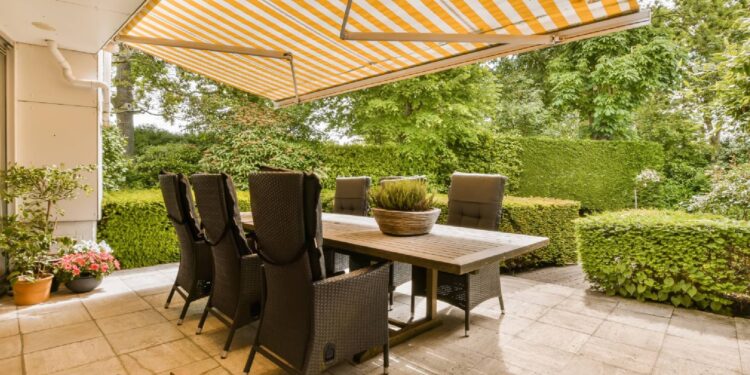Outdoor living spaces are an extension of the home, offering a place to relax, entertain, and enjoy the beauty of the outdoors. However, the comfort and usability of these areas can be greatly impacted by the weather. To maximise their enjoyment, homeowners are increasingly turning to the practical and aesthetic benefits of outdoor awnings. These versatile structures not only enhance comfort by providing shade and protection from the elements but also contribute to the aesthetics of outdoor spaces.
The Functional Benefits of Outdoor Awnings
One of the primary advantages of installing outdoor awnings is the protection they offer from the harsh rays of the sun. With the ozone layer depletion and the increased risk of sunburn and skin cancer, providing shade is essential, especially in areas with high UV indexes.
Awnings also extend the usability of outdoor spaces by shielding them from light rain, allowing for outdoor activities to continue despite unfavourable weather. By reducing the amount of direct sunlight that hits windows and doors, these awnings help to maintain cooler indoor temperatures, contributing to energy savings and reduced air conditioning costs.
The convenience of outdoor awnings ranges from manual retraction mechanisms to motorised systems. This means the level of shade can be adjusted as needed, making outdoor spaces adaptable to different weather conditions at the touch of a button.
Design Aesthetics and Material Considerations
When choosing outdoor awnings, the design and material are critical factors to consider. Awnings come in a variety of styles, colours, and patterns, which allows homeowners to select an option that complements their exterior design. Durable materials such as acrylic, polyester, and canvas are commonly used to withstand the elements, including UV radiation, rain, and wind.
Beyond functionality, the style of awnings can also play a role in enhancing the overall appearance of a home’s façade. Whether you prefer a traditional look or a modern, streamlined aesthetic, there is an awning style to suit your design preferences. As an outward representation of your home’s character, the awning can serve as an accent piece or a subtle addition that seamlessly blends with your outdoor décor.
When it comes to installation, professional fitting is essential to ensure the awning is secure and operates effectively. A properly installed awning provides peace of mind and extends the life of the product.
Indoor Shading Solutions
Awnings are not the only shading option for those seeking to control light and privacy within their homes. Interior shading options such as curtain tracks and timber venetian blinds offer additional functionality and aesthetic choices for managing indoor light and privacy with elegance.
Curtain tracks, for instance, provide a smooth system to draw curtains aside or close them effortlessly. They can be hidden or designed as a feature element in a room. Their versatility extends to how they can be customised for differing widths and lengths, accommodate various fabrics, and fit unique window shapes.
For a more traditional approach, timber venetian blinds offer a natural and warm aesthetic while granting precise control over light and privacy. Their adjustable slats can be tilted to let in natural light or closed completely for full privacy. Besides, real timber blinds add a touch of nature indoors, contributing to a calming and welcoming atmosphere.
Both curtain tracks and timber venetian blinds can be integrated into smart home systems, allowing for automated control that can adjust to time of day, sunlight levels, and even homeowner preferences.
Considering Durability and Maintenance
Longevity is an additional consideration when investing in outdoor awnings. To ensure an awning remains functional and attractive over time, it must be made of high-quality materials resistant to fading, mildew, and deterioration. Maintenance is relatively simple, often requiring only occasional cleaning with mild soap and water to remove dirt and debris.
These maintenance considerations also apply to indoor solutions like curtain tracks and timber venetian blinds, where regular dusting and, for blinds, occasional treatment with wood-safe cleaners will maintain their appearance and functionality.
Environmental Impact
Environmentally conscious homeowners will also appreciate that outdoor awnings can have a positive impact on their home’s ecological footprint. By reducing direct sunlight entering the home, awnings can cut down on the need for air conditioning, consequently reducing energy consumption. Similarly, indoor shading options can assist in insulating rooms, further mitigating energy usage.
Furthermore, there is a growing trend towards the use of recycled and sustainable materials in the construction of awnings and blinds, appealing to those who prioritise eco-friendly products.
The Path to Enhanced Outdoor Living
A well-chosen awning can transform an outdoor area into a functional, beautiful extension of the home. Offering both shelter and a decorative touch, outdoor awnings enable homeowners to personalise their living spaces and embrace the outdoors in comfort and style.
Similarly, indoor shading solutions like curtain tracks and timber venetian blinds provide privacy, light control, and an additional layer of décor within the home. Their ease of use and range of styles make them an essential consideration for any homeowner looking to enhance their living environment.
In summary, embracing the versatility of outdoor and indoor shading solutions is not only about elevating comfort and style but also about improving the functionality of living spaces. With options to suit every design and functional requirement, homeowners can create environments that cater to both their practical needs and aesthetic desires.












